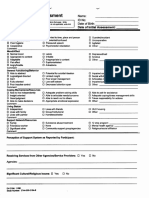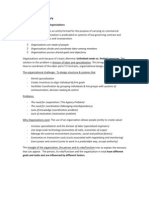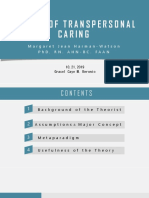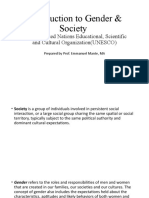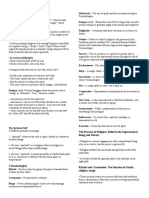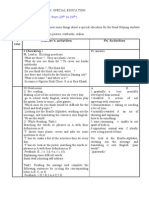Abraham Maslow's Hierarchy of Needs
Abraham Maslow's Hierarchy of Needs
Uploaded by
Dr. Celeste FabrieCopyright:
Available Formats
Abraham Maslow's Hierarchy of Needs
Abraham Maslow's Hierarchy of Needs
Uploaded by
Dr. Celeste FabrieCopyright
Available Formats
Share this document
Did you find this document useful?
Is this content inappropriate?
Copyright:
Available Formats
Abraham Maslow's Hierarchy of Needs
Abraham Maslow's Hierarchy of Needs
Uploaded by
Dr. Celeste FabrieCopyright:
Available Formats
Hierarchy of Needs
The Five Levels of Maslow's Hierarchy of Needs
By Kendra Cherry, About.com Guide
Maslow's Hierarchy of Needs J. Finkelstein Psychologist Abraham Maslow first introduced his concept of a hierarchy of needs in his 1943 paper "A Theory of Human Motivation" and his subsequent book Motivation and Personality. This hierarchy suggests that people are motivated to fulfill basic needs before moving on to other, more advanced needs. This hierarcy is most often displayed as a pyramid. The lowest levels of the pyramid are made up of the most basic needs, while the more complex needs are located at the top of the pyramid. Needs at the bottom of the pyramid are basic physical requirements including the need for food, water, sleep, and warmth. Once these lower-level needs have been met, people can move on to the next level of needs, which are for safety and security. As people progress up the pyramid, needs become increasingly psychological and social. Soon, the need for love, friendship, and intimacy become important. Further up the pyramid, the need for personal esteem and feelings of accomplishment take priority. Like Carl Rogers, Maslow emphasized the importance of self-actualization, which is a process of growing and developing as a person in order to achieve individual potential.
Types of Needs
Maslow believed that these needs are similar to instincts and play a major role in motivating behavior. Physiological, security, social, and esteem needs are deficiency needs (also known as D-needs), meaning that these needs arise due to deprivation. Satisfying these lower-level needs is important in order to avoid unpleasant feelings or consequences. Maslow termed the highest-level of the pyramid as growth needs (also known as being needs or B-needs). Growth needs do not stem from a lack of something, but rather from a desire to grow as a person.
Five Levels of the Hierarchy of Needs
There are five different levels in Maslows hierarchy of needs:
1. Physiological Needs These include the most basic needs that are vital to survival, such as the need for water, air, food, and sleep. Maslow believed that these needs are the most basic and instinctive needs in the hierarchy because all needs become secondary until these physiological needs are met.
2. Security Needs These include needs for safety and security. Security needs are important for survival, but they are not as demanding as the physiological needs. Examples of security needs include a desire for steady employment, health insurance, safe neighborhoods, and shelter from the environment.
3. Social Needs These include needs for belonging, love, and affection. Maslow considered these needs to be less basic than physiological and security needs. Relationships such as friendships, romantic attachments, and families help fulfill this need for companionship and acceptance, as does involvement in social, community, or religious groups.
4. Esteem Needs After the first three needs have been satisfied, esteem needs becomes increasingly important. These include the need for things that reflect on self-esteem, personal worth, social recognition, and accomplishment.
5. Self-actualizing Needs This is the highest level of Maslows hierarchy of needs. Self-actualizing people are self-aware, concerned with personal growth, less concerned with the opinions of others, and interested fulfilling their potential.
Criticisms of Maslows Hierarchy of Needs
While some research showed some support for Maslow's theories, most research has not been able to substantiate the idea of a needs hierarchy. Wahba and Bridwell reported that there was little evidence for Maslow's ranking of these needs and even less evidence that these needs are in a hierarchical order. Other criticisms of Maslow's theory note that his definition of self-actualization is difficult to test scientifically. His research on self-actualization was also based on a very limited sample of individuals, including people he knew as well as biographies of famous individuals that Maslow believed to be self-actualized, such as Albert Einstein and Eleanor Roosevelt. Regardless of these criticisms, Maslows hierarchy of needs represents part of an important shift in psychology. Rather than focusing on abnormal behavior and development, Maslow's humanistic psychology was focused on the development of healthy individuals.
While there was relatively little research supporting the theory, hierarchy of needs is wellknown and popular both in and out of psychology. In a study published in 2011, researchers from the University of Illinois set out to put the hierarchy to the test. What they discovered is that while fulfillment of the needs was strongly correlated with happiness, people from cultures all over the reported that self-actualization and social needs were important even when many of the most basic needs were unfulfilled.
You might also like
- Karen HorneyDocument15 pagesKaren Horneyphotocopyshop. rwuNo ratings yet
- DSM Iv TRDocument1 pageDSM Iv TRJehannah Dayanara Berdan HayudiniNo ratings yet
- Psychosocial Assessment Form1 PDFDocument4 pagesPsychosocial Assessment Form1 PDFWindiGameliNo ratings yet
- Organization SummaryDocument32 pagesOrganization SummaryJakota91No ratings yet
- Complexity, Liking and FamiliarityDocument12 pagesComplexity, Liking and FamiliarityAjaNo ratings yet
- The 5 Levels of Maslows Hierarchy of Needs - VerywellmindDocument5 pagesThe 5 Levels of Maslows Hierarchy of Needs - Verywellmindshchong888No ratings yet
- Self PerceptionDocument2 pagesSelf PerceptionSaurabh Pote100% (1)
- Erik Erikson Theory: Psychosocial DevelopmentDocument36 pagesErik Erikson Theory: Psychosocial DevelopmentRichard RamosNo ratings yet
- Current Issues in PsychologyDocument2 pagesCurrent Issues in PsychologyMika Jenel DamianNo ratings yet
- The Concept of Physical Self in PsychologyDocument2 pagesThe Concept of Physical Self in PsychologyJohn NavaNo ratings yet
- Chapter 6 - Practicing As An Ethical AdministratorDocument5 pagesChapter 6 - Practicing As An Ethical AdministratorJR Rolf Neuqelet100% (1)
- Defense MechanismDocument24 pagesDefense MechanismVince DulayNo ratings yet
- Chap1-3 THESISDocument33 pagesChap1-3 THESISanniNo ratings yet
- 10 Defense MechanismsDocument5 pages10 Defense MechanismsLim JaeBeomNo ratings yet
- Module 7-Mental-Health-and-Well-BeingDocument17 pagesModule 7-Mental-Health-and-Well-BeingDenisse Shazz Mae MaretNo ratings yet
- Aaron Beck Cognitive TheoryDocument4 pagesAaron Beck Cognitive TheoryAnushka Ridhi HiraNo ratings yet
- Obsessive Compulsive Related Disorders: PSYC 340Document21 pagesObsessive Compulsive Related Disorders: PSYC 340Sana FatimaNo ratings yet
- TFN TheoriesDocument3 pagesTFN TheoriesAngel JuNo ratings yet
- Harry Stack SullivanDocument13 pagesHarry Stack Sullivanxiejie22590100% (1)
- Chapter 3 Human DevelopmentDocument6 pagesChapter 3 Human Developmenthumanupgrade100% (2)
- Components of PersonalityDocument4 pagesComponents of Personalityroxsunny100% (3)
- Theories of Development: Early Childhood)Document3 pagesTheories of Development: Early Childhood)Sofia Marie Galendez100% (1)
- Living TreeDocument1 pageLiving TreeZia PustaNo ratings yet
- Grand Theories: Ns. Suryanto, S.Kep., M.Nurs, PHDDocument43 pagesGrand Theories: Ns. Suryanto, S.Kep., M.Nurs, PHDdiah kristinaNo ratings yet
- Jetlag: Jet Lag, Medically Also Called Desynchronosis and FlightDocument26 pagesJetlag: Jet Lag, Medically Also Called Desynchronosis and FlightmyythNo ratings yet
- Human Person and Values DevelopmentDocument2 pagesHuman Person and Values DevelopmentDanica Anne CambaNo ratings yet
- Carl Rogers TheoryDocument24 pagesCarl Rogers TheorySamit RajanNo ratings yet
- THE Emotion: Nature and ManagementDocument14 pagesTHE Emotion: Nature and ManagementJhupit Ganihay100% (1)
- Genie, The Feral Child: Zamboanga City State Polytechnic CollegeDocument2 pagesGenie, The Feral Child: Zamboanga City State Polytechnic CollegeAiko SansonNo ratings yet
- Introduction To Theories of Personality NotesDocument1 pageIntroduction To Theories of Personality NotesZai CassyNo ratings yet
- Biography of Murray (1893-1988) : PersonologyDocument6 pagesBiography of Murray (1893-1988) : PersonologyMing100% (1)
- Freud's Psychosexual Stages of DevelopmentDocument3 pagesFreud's Psychosexual Stages of Developmentwaleedms068467No ratings yet
- Common Defense MechanismsDocument38 pagesCommon Defense MechanismsIris FelicianoNo ratings yet
- LESSON 2 Sociological Perspective of The SelfDocument5 pagesLESSON 2 Sociological Perspective of The SelfMary Joy CornelioNo ratings yet
- Abnormal Psychology Module 1 Understanding Abnormal BehaviorDocument31 pagesAbnormal Psychology Module 1 Understanding Abnormal BehaviorSumriddhi Srivastava100% (1)
- Jean Watson Report 8 TFNDocument19 pagesJean Watson Report 8 TFNBTW DespairNo ratings yet
- Representation of Beauty Standards in Films Imperfect: Career, Love & ScalesDocument7 pagesRepresentation of Beauty Standards in Films Imperfect: Career, Love & ScalesKylei EraNo ratings yet
- Filipino PsychologyDocument2 pagesFilipino PsychologyRolan Dave FaldasNo ratings yet
- TFN 3rd Exam ReviewerDocument9 pagesTFN 3rd Exam ReviewerTrizza VelosoNo ratings yet
- What Is Psychoanalytic Therapy: Dream Interpretation: According To Freud, Dream Analysis Is by Far TheDocument2 pagesWhat Is Psychoanalytic Therapy: Dream Interpretation: According To Freud, Dream Analysis Is by Far Thebuhari rabiuNo ratings yet
- Abnormal Psychology - Past and PresentDocument19 pagesAbnormal Psychology - Past and PresentRizwana MBTNo ratings yet
- Behavioral Management TheoryDocument2 pagesBehavioral Management TheoryrazrealNo ratings yet
- Nursing Interview Guide To Collect Subjective Data From The ClientDocument6 pagesNursing Interview Guide To Collect Subjective Data From The ClientAlliana Denice VicencioNo ratings yet
- Bioethics in ResearchDocument44 pagesBioethics in ResearchJonathan100% (1)
- Chapter 1 Health PsyDocument8 pagesChapter 1 Health Psyhadiqaasif01No ratings yet
- Steps of Health AssesmentDocument3 pagesSteps of Health AssesmentA CNo ratings yet
- Psych Stats Intro To Psych StatsDocument7 pagesPsych Stats Intro To Psych Statscarmelalouis.trinidadNo ratings yet
- TFN Report SCDocument14 pagesTFN Report SCHasanuddin100% (3)
- History of Philippine Psychology - Filipino PsychologyDocument3 pagesHistory of Philippine Psychology - Filipino PsychologyMS ValienteNo ratings yet
- Final PaperDocument15 pagesFinal PaperMTCNo ratings yet
- Lesson 7 9 ReviewerDocument5 pagesLesson 7 9 ReviewerWinsher PitogoNo ratings yet
- FilpsyDocument1 pageFilpsyPolsNo ratings yet
- Intro. To Gender Society PDFDocument27 pagesIntro. To Gender Society PDFMark Anthony MilarNo ratings yet
- Understanding The SelfDocument4 pagesUnderstanding The SelfMa. Katrina Veronica TangubNo ratings yet
- Activity 1 and 2Document2 pagesActivity 1 and 2Trisha LaidenNo ratings yet
- Carolyn Weiner ReportDocument4 pagesCarolyn Weiner ReportJerome Clark CidNo ratings yet
- Erickson Theory NewDocument5 pagesErickson Theory NewAngeline Pankaj TirkeyNo ratings yet
- Physical and Cognitive Development in Middle Adulthood 40 60 YearsDocument24 pagesPhysical and Cognitive Development in Middle Adulthood 40 60 YearsChoun fairyNo ratings yet
- Theories of Personality 8 (Harry Stack Sullivan)Document45 pagesTheories of Personality 8 (Harry Stack Sullivan)Anne Jeanneth DiazNo ratings yet
- Hierarchy of NeedsDocument3 pagesHierarchy of NeedsAashiNo ratings yet
- Personality. This Hierarchy Suggests That People Are MotivatedDocument4 pagesPersonality. This Hierarchy Suggests That People Are MotivatedemkyujNo ratings yet
- The Psychology of Pyramid SchemesDocument9 pagesThe Psychology of Pyramid SchemesDr. Celeste FabrieNo ratings yet
- Frustration - An Emotional Rollercoaster! "Following The Yellow Brick Road Phenomenon" - Wizard of OzDocument4 pagesFrustration - An Emotional Rollercoaster! "Following The Yellow Brick Road Phenomenon" - Wizard of OzDr. Celeste FabrieNo ratings yet
- Swiss Military - Juggling Army and Career" - What Makes The Swiss Tick?Document9 pagesSwiss Military - Juggling Army and Career" - What Makes The Swiss Tick?Dr. Celeste FabrieNo ratings yet
- The Insanity DefenseDocument3 pagesThe Insanity DefenseDr. Celeste Fabrie100% (2)
- Employees Wellness ProgramDocument6 pagesEmployees Wellness ProgramDr. Celeste Fabrie100% (3)
- Histrionic Personality DisorderDocument3 pagesHistrionic Personality DisorderDr. Celeste Fabrie100% (3)
- Me Tarzan. You Jane. Basta!Document6 pagesMe Tarzan. You Jane. Basta!Dr. Celeste Fabrie100% (1)
- Felix The Flying Frog Parable Modern ManagementDocument3 pagesFelix The Flying Frog Parable Modern ManagementDr. Celeste FabrieNo ratings yet
- Doctrine For The Armed Forces USA 2013 PDFDocument172 pagesDoctrine For The Armed Forces USA 2013 PDFDr. Celeste Fabrie100% (1)
- Rechtsprache Englisch Exam 27.01.2012Document11 pagesRechtsprache Englisch Exam 27.01.2012Dr. Celeste FabrieNo ratings yet
- Leaders Vs Managers Power-PointDocument18 pagesLeaders Vs Managers Power-PointDr. Celeste FabrieNo ratings yet
- Problem Solving in Autocratic VsDocument3 pagesProblem Solving in Autocratic VsDr. Celeste FabrieNo ratings yet
- Twilight of The GodsDocument1 pageTwilight of The GodsDr. Celeste FabrieNo ratings yet
- Gecs Chemicals SupplementDocument8 pagesGecs Chemicals SupplementDr. Celeste FabrieNo ratings yet
- Methods of Research Calmorin Chapter 1Document46 pagesMethods of Research Calmorin Chapter 1Peter GonzagaNo ratings yet
- Rapid Incident Restoration: What It IsDocument2 pagesRapid Incident Restoration: What It IsJJ AsonyerNo ratings yet
- HR Trends in 2018 - HRKathaDocument2 pagesHR Trends in 2018 - HRKathaNikita ZutshiNo ratings yet
- Primary Progressive Aphasia: A 25-Year RetrospectiveDocument4 pagesPrimary Progressive Aphasia: A 25-Year RetrospectiveDranmar AhmedNo ratings yet
- UedDocument22 pagesUedAthirahNo ratings yet
- Professional Year Program BSBDIV301 - Working With Diversity Assessment Task 2.2 - Short Answer Questions & Case StudyDocument3 pagesProfessional Year Program BSBDIV301 - Working With Diversity Assessment Task 2.2 - Short Answer Questions & Case Studypun chin wai0% (1)
- COREQ CheckList Untuk Penelitian KualitatifDocument9 pagesCOREQ CheckList Untuk Penelitian KualitatifRosnidar SumardiNo ratings yet
- Critical Reading ModuleDocument80 pagesCritical Reading ModuleCOAK CORONo ratings yet
- How To Write A ReportDocument10 pagesHow To Write A ReportMIHAELA-ELENA ZAMFIRNo ratings yet
- Personal Development Reporting Group 3 MidasDocument24 pagesPersonal Development Reporting Group 3 MidasJustine Margate LautingcoNo ratings yet
- Week 3B - PPT - Concept PaperDocument26 pagesWeek 3B - PPT - Concept Paperalfaizal.jumahNo ratings yet
- HRM Types of InterviewDocument4 pagesHRM Types of InterviewHASEEB100% (1)
- Lesson 2 Hanyu Bu Tai NanDocument6 pagesLesson 2 Hanyu Bu Tai NanClaudia CristinaNo ratings yet
- Literary Impressionisms: Dipartimento Di Lingue e Letterature StraniereDocument186 pagesLiterary Impressionisms: Dipartimento Di Lingue e Letterature Stranieresinggih kusanagiNo ratings yet
- S1O1 FamilyRelationshipsDocument24 pagesS1O1 FamilyRelationshipssksj cusjsNo ratings yet
- The Use of Cartoons As A Teaching Tool To Enhance Student Learning in Economics EducationDocument15 pagesThe Use of Cartoons As A Teaching Tool To Enhance Student Learning in Economics EducationZain SalamNo ratings yet
- Introduction To Psychological TestingDocument5 pagesIntroduction To Psychological Testingabdu raufNo ratings yet
- MBA Emailer Brochure - GB20190823Document11 pagesMBA Emailer Brochure - GB20190823TTNo ratings yet
- 21st Century SkillsDocument22 pages21st Century SkillsJosh RoxasNo ratings yet
- (Nkonko M. Kamwangamalu (Auth.) ) Language Policy ADocument252 pages(Nkonko M. Kamwangamalu (Auth.) ) Language Policy AUk matsNo ratings yet
- Computer-Assisted Instruction in The Mathematics Intervention ClaDocument32 pagesComputer-Assisted Instruction in The Mathematics Intervention ClaNOVA LEAH BULANDRESNo ratings yet
- Unit 4Document9 pagesUnit 4thai_nhhNo ratings yet
- Lovelle G. Correa, LPT Rizal College of Taal Guro Sa Filipino 8Document2 pagesLovelle G. Correa, LPT Rizal College of Taal Guro Sa Filipino 8Marielle TenorioNo ratings yet
- Notes Tesl MethodologyDocument8 pagesNotes Tesl MethodologyTadika Cemerlang Seri EmasNo ratings yet
- ACR Catch Up FridayDocument3 pagesACR Catch Up FridayGrace Joy S ManuelNo ratings yet
- FS 2 Le 13Document8 pagesFS 2 Le 13John Michael TapallaNo ratings yet
- Application of Artificial Intelligence AI in FoodDocument8 pagesApplication of Artificial Intelligence AI in FoodMarwa ARNo ratings yet
- New Building Bridges 5: Borka Lekaj Lubina Jasna Pavuna Danka SingerDocument10 pagesNew Building Bridges 5: Borka Lekaj Lubina Jasna Pavuna Danka SingerIrma LomtatidzeNo ratings yet
- IELTS Preparation and Practice: ListeningDocument10 pagesIELTS Preparation and Practice: ListeningDtn NgaNo ratings yet


